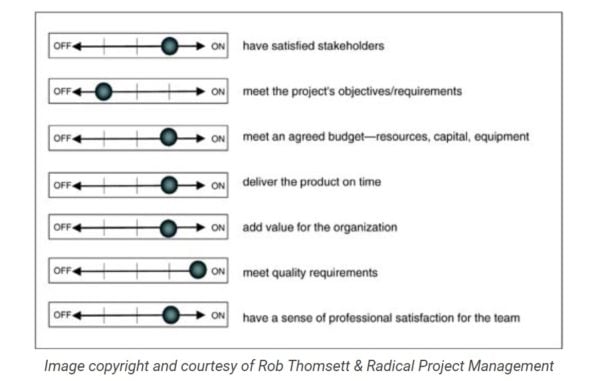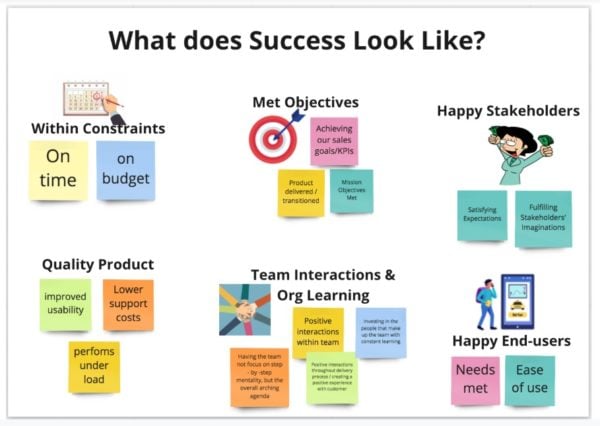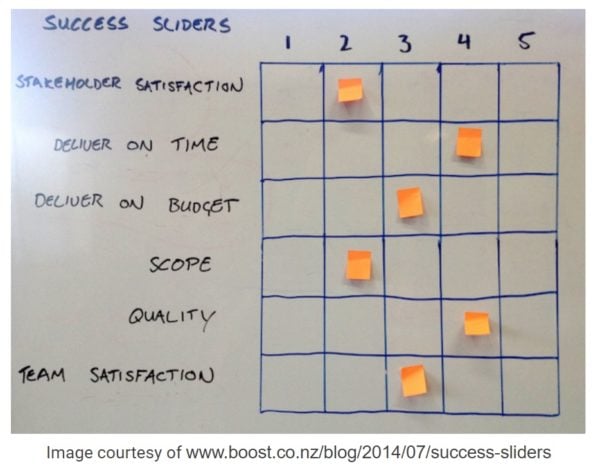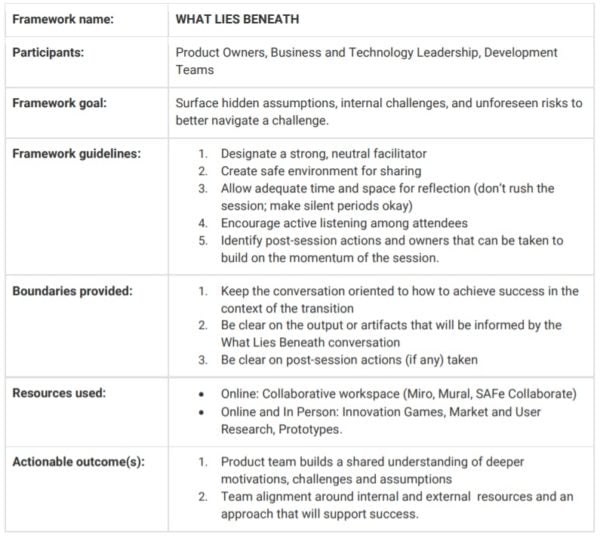What’s often forgotten by those deeply familiar with a well-established approach, or paradigm, is the long corridor between the old door — Waterfall — that has closed and the new door — Agile — that stands open.
In this article, we describe two essential frameworks to guide your Agile transformation — and expert instruction on how to apply them.
Exit Waterfall Management
The “Tyranny of the Waterfall” was a phrase Ken Schwaber, the co-founder of the Scrum process framework, would use to describe the thinking and behaviors that persist in people as an Agile approach is adopted. The mindset and model of defined process control traces its roots back to the Principles of Scientific Management published in the early 20th century by Fredrick Taylor.
Enough has already been written on the origins of the Waterfall method and its shortcomings when applied to knowledge work and specifically software development. In the context of transitioning out of this decades-old, dominant way of thinking and working, what you need to know as someone who is guiding this transition is the following:
- Waterfall is an inherited model (from process control methods at the outset of the industrial revolution and subsequently in civil engineering and construction project management).
- The model may work well in environments of low-change, low learning, and low variability.
- The model and the impulse to apply it for the sake of consistency and control is deeply embedded in the thinking and behaviors of our workforce.
- The “battleground” for the transition is the mindset that underpins the model, i.e., 1) there’s one right way to do things; and, 2) managers manage and workers work.
While largely inappropriate for the high-change, high-learning, and high-variability world of software development, some aspects of the model, such as chartering, remain relevant and may be retained and applied regardless of the process model you employ.
Enter Agile Transformation
Lured by the promise of increased innovation, shorter time-to-market, happier customers and improved product quality, organizations large and small, public and private, have turned to Agile and the Scrum process framework to manage their work.
Short development cycles, small batches of work, and feedback that drives learning are the procedural hallmarks of the Scrum process framework. A bias for action, an orientation to customer value, and a willingness to collaborate across boundaries comprise the mindset of a Scrum practitioner.

Given the stark difference between these two models, the transition to Agile can be assisted by using two powerful frameworks: Success Sliders, a convergent framework, and What Lies Beneath, a divergent framework. In applying these frameworks in your environment, consider the following:
- Start with a pilot — select a product team or business unit with a manageable market segment or persona set and internal governance to assist the transition.
- Clarify goals – establish the high-level business goals (e.g., drive subscriptions, reduce support costs) of the pilot initiative.
- Communicate widely – broadcast the goals and intent (e.g,. transition to a new delivery model) within the team and across the organization.
- Explore and experiment – each of these transition frameworks thrives on openness, honesty, and a willingness to try new things; establish this culture as best you can.
These two essential frameworks are designed to work together for maximum gain. They are complementary.
Framework 1: Sucess Sliders
Success Sliders, a framework adapted from Rob Thomsett’s “Project Success Sliders” in his book Radical Project Management, offers a way for the pilot team and key stakeholders to openly and collaboratively align on the motivations and aspirations for the transition. This alignment is key as it will set expectations and provide motivation for facing the challenges inherent to the journey.

Success Sliders define the collective “Why?” behind the transition, and gives the pilot group and stakeholders a shared destination upon which to focus as they take steps together. Success Sliders are applied in 3 distinct steps:
- Brainstorm the elements of success.
- Affinity-map the elements into 5-7 categories
- Build the “Slider Board” and facilitate alignment with voting.
Success sliders are a way to step away from the method, i.e., how you’ll get there, and instead align on the destination and what constitutes success for the initiative.
1. Brainstorm the Elements of Success
“What does success look like for this transition?” is the opening question to the pilot team and stakeholder community. As with brainstorming, there are no “wrong” answers and all responses are encouraged and supported. Responses will typically fall into in two broad categories:
- Product – elements of success specifically related to the market or customer impact of the product or service that is being built or enhanced by the pilot team. Customer adoption, reduced support costs, or increased revenue are some examples of product success.
- Process – aspects of success that relate more generally to the environment, interactions, and process within which the pilot is being undertaken. Sustainable pace, decreased delays or organizational learning are examples of process success.
It’s healthy to validate and encourage contributions in both of these two dimensions to form a richer, more diverse, and more complete picture of Success for the transition being undertaken.
2. Affinity-Map the Elements into 5-7 Categories
Once the pilot team and stakeholders have brainstormed attributes of success, affinity map the elements into 5-7 categories and give each category an appropriate name. The categories and naming should reflect the success characteristics that are most important and interesting to the pilot team and stakeholder group assembled. These “Dimensions of Success” can be clustered and visually represented in a way similar to the virtual flip-chart below.

3. Build the Board & Facilitate Alignment
Build the board by creating a physical or virtual table comprised of five columns and five to seven rows for each of the success dimensions. Label the rows with your success dimensions as shown in the figure below.

Place post it notes to serve as markers that are intended to move or slide in column 3 of each row. Instruct your attendees that they are now to rank the success factors from most important (5) to least important (1) for each of the 5-7 dimensions that you’ve placed on the board.
The only constraint is that the sum total of rankings must equal 3 x [no. of success dimensions] and they must arrive at an agreed upon allocation of the points as a group. For example, if you have 5 success dimensions, attendees will have 15 points (3×5) to allocate across the entire slider board. It’s important to respect the numeric constraint, which forces conversation and ideally alignment on the aspects of success are most important for the pilot program.
Success Sliders can be a valuable way to defuse any existing tensions around “process zealots” by finding common ground and placing attention on what the team is working to create together.
Defining and aligning on the destination of a shared version of success puts focus in a healthy place and enables the team to own and apply the Scrum framework with appropriate practices to achieve success in the defined dimensions.
Download Framework Sucess Sliders
Framework 2: What Lies Beneath
Thus far, we’ve acknowledged the origin as the existing Waterfall approach, the shared destination of a common definition of success and the “new” vehicle, the Scrum process framework, for the journey upon which you and your group are about to embark. As with any journey worth taking, the trip will have inherent challenges, many of which are hidden in unspoken assumptions and in the architecture of people’s minds.
What Lies Beneath is a framework designed to illuminate any challenges or unseen issues before embarking on the transition journey. This framework also has a team-building quality that takes stock of inherent strengths in the pilot group. The framework is ideally suited to the product team and could be incorporated into a liftoff or chartering event.
The object of What Lies Beneath is to create a shared context in order to resolve a difficult problem as well as address any challenges or unseen issues that might prevent success. Many times when new teams are first formed, there is a rush of excitement to get the work done. Unfortunately, deep thinking to explore the problem space from different perspectives is often overlooked.
This framework encourages teams to pause and reflect on their ultimate goal, what sort of obstacles they might encounter along the way and what strengths they bring to the problem.
Applying the Framework
Begin this framework by writing the vision or another focusing goal along the top of a sheet of chart paper. The focusing goal can be visual, verbal, or a combination of the two. Next, on the flipchart beneath the goal, draw a picture of an iceberg with a boat on one side.

This visual framework has four elements:
- People: who are the various people on our boat that can help us reach our goal?
- Stars: what are some intermediate goals that will help guide us and ensure we stay on track?
- Wind: what strengths do we bring as a team that will help us deliver on our goal?
- Obstacles: what are the obvious and non-obvious impediments to our success?
Begin by asking the participants to write down their name on a post-it note and place it into the boat. Allow each person to say a few words about why they are on the team, what role they will perform and what special or non-obvious skills they bring to the team. Next, ask the participants to think of near-term and mid-term goals that show progress towards the ultimate goal, i.e., your big vision. Write these down – one per post-it note – and place them in the sky above the iceberg as the stars.
Now, allow the participants to think of individual, or collective, strengths they have to offer and that will push the boat to their destination. Write each of these items down – one per post-it note one – and place them between the stars and the waterline as the wind.
Finally, ask the participants to identify the various obstacles – one per post-it note – that could sink the project. At the top of the iceberg, ask the participants to place all the obvious obstacles and place at the roots of the iceberg all the obstacles that are difficult to see.
This is a great collaboration framework to use at the outset of an initiative to create internal alignment and understand context from inside of the team.
Download Framework What Lies Beneath
Remember, both Success Sliders and What Lies Beneath can be used together to help you establish a clear and motivating context within which your pilot team can transition from Waterfall delivery to the Scrum Process Framework.
Would You Like to Discuss Your Agile Transformation?
If you would like to learn more about using Success Sliders or What Lies Beneath, or if you would like to speak to one of our Agile Adoption experts, please contact us today!
And be sure to follow us on Linkedin, Twitter and/or Facebook to hear when new blogs are published and webinars are scheduled on interesting Scrum and Agile topics.
*Written by Kert Peterson






